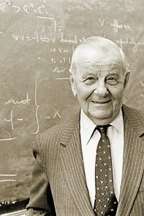Antoni Zygmund
| Antoni Zygmund | |
|---|---|
 Antoni Zygmund | |
| Born |
December 25, 1900 Warsaw, Congress Poland |
| Died |
May 30, 1992 (aged 91) Chicago, Illinois, United States |
| Nationality | Polish |
| Citizenship | Polish, American |
| Alma mater | Warsaw University (Ph.D., 1923) |
| Known for | Singular integral operators |
| Awards |
Leroy P. Steele Prize (1979) National Medal of Science (1986) |
| Scientific career | |
| Fields | Mathematics |
| Institutions |
University of Chicago Stefan Batory University |
| Doctoral advisor |
Aleksander Rajchman Stefan Mazurkiewicz |
| Doctoral students |
Alberto Calderón Elias M. Stein Paul Cohen |
Antoni Zygmund (December 25, 1900 – May 30, 1992) was a Polish mathematician. He is considered one of the greatest analysts of the 20th century. His main area of interest was harmonic analysis.
Biography
Born in Warsaw, Zygmund obtained his Ph.D. from Warsaw University (1923) and became a professor at Stefan Batory University at Wilno (1930–39). In 1940, during the World War II occupation of Poland, he emigrated to the United States and became a professor at Mount Holyoke College in South Hadley. From 1945 until 1947 he was a professor at the University of Pennsylvania, and from 1947 at the University of Chicago.
He was a member of several scientific societies. From 1930 until 1952 he was a member of the Warsaw Scientific Society (TNW), from 1946 a member of the Polish Academy of Learning (PAU), from 1959 a member of the Polish Academy of Sciences (PAN), and from 1961 a member of the National Academy of Science in Washington, D.C.. In 1986 he received the National Medal of Science.
His main interest was harmonic analysis. He wrote in Polish what soon became, in its English translation, the standard text in analysis, the two-volume Trigonometric Series. His students included Alberto Calderón, Paul Cohen, Nathan Fine, Józef Marcinkiewicz, Victor L. Shapiro, Guido Weiss, Elias Stein and Misha Cotlar. He died in Chicago.
His work has had a pervasive influence in many fields of mathematics, particularly in mathematical analysis. Perhaps most important was his work with Calderón on singular integral operators.
Mathematical objects named after Zygmund
Books
- Trigonometric Series (Cambridge University Press 1959, Dover 1955)
- Intégrales singulières (Springer-Verlag, 1971)
- Trigonometric Interpolation (University of Chicago, 1950)
- Measure and Integral: An Introduction to Real Analysis, With Richard L. Wheeden (Marcel Dekker, 1977)
See also
References
- Kazimierz Kuratowski, A Half Century of Polish Mathematics: Remembrances and Reflections, Oxford, Pergamon Press, 1980, ISBN 0-08-023046-6.
- Zygmund, A. (2002) [1935], Trigonometric series. Vol. I, II, Cambridge Mathematical Library (3rd ed.), Cambridge University Press, ISBN 978-0-521-89053-3, MR 1963498 [1][2][3]
- ↑ Salem, Raphael (1960). "Review: Trigonometric Series by A. Zygmund, 2nd. ed., vols. I and II" (PDF). Bull. Amer. Math. Soc. 66 (1): 6–12. doi:10.1090/S0002-9904-1960-10362-X.
- ↑ The 2nd edition (Cambridge U. Press, 1959) consists of 2 separate volumes. The 3rd edition (Cambridge U. Press, 2002) consists of the two volumes combined with a foreword by Robert A. Fefferman.
- ↑ Tamarkin, J. D. (1936). "Review: Trigonometric Series by A. Zygmund, 1st edn" (PDF). Bull. Amer. Math. Soc. 42 (1): 11–13. doi:10.1090/s0002-9904-1936-06235-x. The first edition (vol. V of the series Monografje Matematyczne, 1935) consists of iv+320 pp. The third edition consists of foreword: xii; vol. I: xiv+383 pp.; vol. II: viii+364 pp.
Further reading
- Gray, Jeremy (1970–80). "Zygmund, Antoni". Dictionary of Scientific Biography. 25. New York: Charles Scribner's Sons. pp. 414–416. ISBN 978-0-684-10114-9.